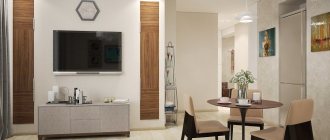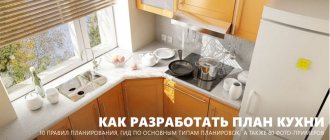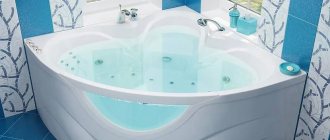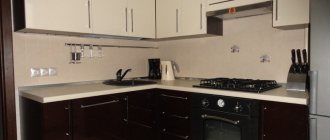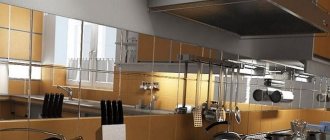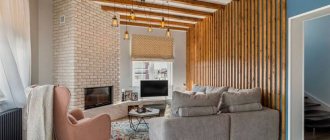If you think that brick can only be used for exterior decoration, you are mistaken. Designers often use this material when decorating various types of premises. However, most often brick walls are decorated in the kitchen - a reliable, durable and beautiful material has excellent performance properties and adds coziness to the room.
The use of brick makes any kitchen original and cozy
Read our article about how to properly decorate a kitchen using brick, what its features are and how best to use brick elements in the interior.
Advantages and disadvantages of brick in the kitchen
Like any finishing material, brick has both its pros and cons. Moreover, both of them can be considered quite significant.
A brick wall is a beautiful, but rather difficult move
It should be noted that brickwork in general is a rather unique material - on the one hand, it looks very stylish, on the other hand, it must be used carefully in the interior so as not to get the effect of an unrenovated room.
So, let's look at the list of advantages of brick in the interior:
- First of all, these are its operational properties. Brick is a reliable and durable material that can withstand difficult conditions in the kitchen. Constant moisture, temperature changes, greasy drops - all this will not cause significant damage to your wall. Therefore, brick is often used, among other things, for finishing the apron.
- The brick wall looks very unusual and attracts attention. This finish looks stylish and beautiful, if, of course, you managed to correctly use it in the interior.
- This is one of the most economical ways to decorate a wall. You will not need additional finishing, and the brick itself is not too expensive.
- The material has excellent heat and sound insulation properties, so there is no need to lay a separate insulating layer.
- In fact, brick is a universal material . It is used not only for wall decoration, but also for floors, ceilings, decorating a kitchen island or bar counter, and an apron. All this allows you to create an original and holistic interior.
- If you wish, you can do without the help of builders - laying brickwork in one row is not difficult with your own hands , even if you have never done repairs before.
- Brickwork is a great way to zoning space . By decorating a wall or part of it in this way, you can separate the kitchen area from the dining room and allocate a specific place in the kitchen.
- Brick goes well with all other materials. Wallpaper, tiles, decorative plaster - you are practically unlimited in finishing combinations.
As you can see, brick is an inexpensive material that can be widely used in the interior of the kitchen. In addition, it has excellent performance properties.
What about the downsides? Let's see what you need to be careful about when working with brick:
- If after the list of advantages you have a desire to decorate all the walls with brickwork, you will have to abandon it. Brick should be used sparingly in the interior, even if you are a fan of the urban loft. Otherwise, instead of a beautiful and cozy kitchen, you risk getting a strange room that evokes associations with an abandoned construction site.
- Despite its strength, brick requires very careful maintenance. It has a porous, heterogeneous structure. Due to this, grease and dirt accumulate in the seams. This means that you will have to wipe such a wall regularly - otherwise you risk quickly ruining the appearance of the wall.
- If you choose red brick to decorate the room, you won’t be able to save on lighting - you will need a lot of artificial light . Terracotta brick practically does not reflect light fluxes, so you will need many times more lamps than when using other materials.
- As already mentioned, you should handle bricks with care. Especially if you decide to choose dark tones of the finishing material, go a little overboard, and the room will seem gloomy and unkempt.
As you can see, the disadvantages can be considered quite conditional - if you show common sense, correctly design the lighting system and do not forget about caring for the brickwork, such a wall will serve you for a long time without losing its appearance and performance properties.
If there is a lot of brick in the interior, you need to work with it very carefully. With the right approach, brick helps to create a very beautiful interior. Combine brick with less capricious interiors so as not to overload the space.
How to properly use brick in the interior? We hope the advice of our designers will help you with this!
Necessary tool
Bricklaying tools.
When building a kitchen with your own hands, you will need the following tools:
- perforator;
- Bulgarian;
- Grinder;
- hacksaw;
- hacksaw for metal;
- putty knife;
- Master OK;
- paint brush;
- trowel;
- mallet;
- hammer;
- level;
- plumb line;
- ruler.
Tip 1. Study the rough finishing of the kitchen
Perhaps you are lucky and live in a house with brick walls. In this case, we recommend that you do not invent unnecessary problems for yourself - it is quite possible that you will not need to additionally lay decorative bricks.
Sometimes it is enough to remove the finishing trim to get a beautiful brick wall
It will probably be enough just to carefully clean the wall - sand the seams, remove all dirt.
This way you will get a great brick wall without breaking the bank. However, this is not always possible. If you are unlucky with a brick wall, the next point is for you.
The main thing is to balance the interior well
This kitchen looks very original
Photo gallery of brick summer kitchen projects
The photo below shows options for open and closed buildings of different styles with different types of stove complexes.
An equipped summer kitchen is a godsend for summer residents. Oven dishes make regular dinners family occasions, and canning food becomes more convenient and easier outdoors. Therefore, for those who want to relax in comfort and not sweat at the stove in a stuffy room in the summer, building a summer kitchen on their site is an excellent choice.
Tip 2. Decide on materials
At first glance, this advice sounds strange - a brick is a brick. What is to be determined here? However, in fact, the issue is deeper than it might seem at first glance.
A wide variety of materials can be used as bricks in the kitchen.
Most often, special decorative bricks or its imitation are used for the kitchen. Variations are possible here. We recommend that you familiarize yourself with the list of materials to make the right choice.
First of all, we do not recommend using wallpaper with a brick print. Yes, such a coating can be distinguished by high quality printing and at first glance be very reliable. However, the absence of a characteristic structure will completely kill the special charm that is inherent in brick walls.
One of the most popular options is ceramic tiles that imitate brick. Firstly, it is very easy to install. Secondly, the appearance, thanks to the volumetric texture, fully matches the brickwork. In addition, due to the special glaze, such tiles are ideal for finishing an apron - cleaning such a coating is much easier than natural porous brick.
Sand-lime bricks are also good for kitchens. The properties of the material provide them with increased resistance to moisture, steam and temperature changes. Plus, they look very beautiful and authentic. They are produced in various colors. In addition, the coating can be painted - a great way to quickly update your kitchen interior.
Very often, gypsum tiles are used to decorate kitchens. They can be of different shapes and sizes, so using them is easy to recreate any type of brickwork.
Gypsum can be used in different areas of the kitchen
A nice bonus is the thickness of the gypsum blocks. It is only five millimeters, so gypsum is ideal for small kitchens. The color scheme is also pleasing - from the usual white and terracotta to complex, sometimes unexpected colors.
An interesting solution is the use of MDF panels that imitate brickwork. This is perhaps the fastest way to decorate your kitchen like a brick. Due to the fact that the panels are quite large in size, you can lay the entire wall in a matter of hours. In addition, it is almost impossible to visually distinguish a fake from real brickwork. However, remember that in terms of performance properties, brick significantly exceeds the characteristics of MDF panels.
Even this one. the panel can be installed in a matter of hours
Orders
Building a barbecue oven with your own hands is quite a labor-intensive process. Ordering is necessary to perform high-quality masonry. The procedure is as follows:
- Laying the starting tier. The usual cement composition is used, the laying is half a brick. Dimensions of the first tier: clearance of at least 5 cm and height of the tier - 70 cm.
- Next, the iron sheet is laid. The length of the stove is laid out in 2 strips of masonry. A ledge of 1/3 brick is constructed. Next is facing this area with finishing bricks.
- The next step is to create the combustion chamber. It is built according to the characteristics of the drawing. A recess of 3 bricks is created. The required width is 5-6 bricks.
- The next step is laying gaps, arches and walls 9-10 bricks high. The height calculation is done from the earth's surface. When laying out the walls, you need to lay alloy rods on strips 6 and 7. Their protrusion is built to 7 cm. Then a mesh and a pallet are placed on them. The height of the mesh can be adjusted if the rods are laid up to 10 strips.
- This system involves the installation of 2 grilles. The lower one will serve for fuel and its ignition. The top one is for storing goods.
- For the production of a chimney, fire-resistant bricks and a clay mixture are useful. The method of laying 1 brick on top of each other is used. A damper must be inserted into the chimney. A certain bend should be constructed on its rear wall to adjust the draft. The chimney is constructed from 13-16 lines. The longer it is, the better the traction.
- To finish the stove, use either natural granite or facing brick, at the discretion of the owner.
- The tabletop is also made using several methods: from marble slabs, from water-resistant wood, or simply poured with concrete. The choice will depend on the preferences and financial abilities of the owner.
- The final step is to open the seams before the composition hardens.
Tip 3. Decide on the texture
The brick does not have to be porous, like the one we are used to seeing in exterior decoration. Now the blocks are treated with a special glaze, which allows you to give the most varied appearance to the material.
Bricks can be very different
For example, you can use classic matte bricks - they are great for creating traditional interiors.
The usual matte brick
However, glossy glazed bricks also look very interesting. In addition, due to their reflective properties, they visually make a small kitchen larger. A significant bonus, especially when you consider that the brick itself conceals the space, making it smaller and cramped.
Interesting and attractive solution
A fashionable solution for interiors in the industrial loft style is chipped brick. The blocks appear a little broken, their edges are torn, and their texture is uneven. Due to this, the coating seems very voluminous and original. True, you need to work with such material very carefully, otherwise the kitchen will take on a sloppy, abandoned appearance.
Rough finishes should be compensated with elegant furniture
Preparatory work
A project for a summer kitchen begins with choosing a construction site, which takes into account:
- Proximity to the house for connecting the system: water supply;
- electricity;
- sewerage;
Stages:
- Cleaning the construction site.
- Laying out the area using driven pegs and a stretched rope, according to the project.
- Preparation of trenches for supplying underground communications.
- Drawing up working drawings indicating the exact dimensions of the structure.
- Calculation, delivery and storage of necessary materials in groups at the construction site.
- Installation and connection of the necessary equipment: concrete mixer, grinder, etc.
Wooden materials, especially floor beams and rafters, must be dried in natural conditions and treated with special mixtures against various types of pests and moisture.
Tip 4. Find the right color scheme
There is an opinion that brick walls can only be red, terracotta or white. This is fundamentally wrong. Modern possibilities make it possible to give brickwork any color - and we’re not even talking about painting, which gives you the chance to change the interior of the kitchen at least every month.
You can find brick in almost any color
In addition to classic solutions, you can choose almost any color. Brickwork in unexpected tones looks very interesting - blue, pistachio, green, straw.
We recommend choosing textured shades - interspersed with minerals and various decorative additives. This will make your wall seem more original and voluminous.
Bricks painted using the ombre technique look interesting
In addition, you can experiment with color combinations and even lay out a unique brick mosaic. However, keep in mind that such a solution requires quite a lot of financial costs and effort - nevertheless, decorating an ordinary brick wall is much easier. But the result will be much more original.
Take the time to find an interesting type of brick
Finishing touches – interior arrangement
Photo: open extension as a kitchen.
Inside the room it is better to place only the necessary kitchen utensils for preparing dishes, furniture and a sink. Other decorative details should not clutter up the space, and the distance from the stove to other furniture should be at least 1.5 m.
There is no need to hide ceiling beams. They can be highlighted by painting them in a bright color or simply varnishing them. An interesting lamp in the center made of natural materials will complement the picture. A closed kitchen must be equipped with a hood.
For furniture, you should choose a practical wooden table with chairs, benches, and wicker chairs. Windows are usually decorated with transparent tulle or not covered at all. You can hang small decorative lanterns along the façade of the building.
Tip 5. Take care of additional processing
If you want to place a brick directly next to the oven or use it to decorate an apron, we recommend that you additionally cover it with a thin layer of scraping varnish. This will greatly simplify cleaning - dirt and grease will not penetrate the pores of the material, which means the coating will last you longer.
If you want to use brick near the work surface, it is better to further process it
If you are afraid that such processing will spoil the texture of the brick, do not worry. Modern materials can be applied in one layer, so that they form a thin protective film, not too noticeable at first glance.
Modern means make processing invisible
In addition, no one forces you to choose a flashy glossy finish - you can easily use matte varnish.
Roof installation
There are no restrictions in choosing the type of roof. But the easiest to build is considered to be single or double slope. An important installation condition is maintaining the correct angle of inclination.
Suitable materials:
- corrugated metal sheets;
- tiles;
- slate;
- metal tiles;
- ondulin.
To make the roof frame, longitudinal and transverse beams and bars are used, and sheathing is made. If this is a closed building, then before laying the roofing material it is necessary to make a layer of thermal insulation made of mineral wool.
An important stage of roof installation is the installation and removal of the chimney. All work must be carried out in accordance with the set of rules SP 7.13130.2013.
Photo: chimney lining diagram
Therefore, you need to consider the following:
- The optimal pipe height is 5 m and above. With a lower value, problems with traction may occur.
- It is better to install the chimney at the ridge of the roof. If placed lower, there will be a high probability of snow bags in winter.
- The minimum distance of a brick chimney to combustible materials is 13 cm.
- Hydro- and thermal insulation of the pipe is required. In the first case, with a special film, in the second - with basalt mineral wool.
The roofing material must be positioned so that its edges extend beyond the frame. When draining, the water will not enter the room.
After installing the roof, you can begin installing windows and doors.
Tip 6. Try painting the brick to match the walls
Do you have a small kitchen that you want to make more comfortable? A single-color covering for all walls and brick in the dining room or work area is a very suitable solution. To make the room even prettier, we recommend sticking to one color scheme.
Nice monochromatic solution
This way the brickwork will stand out only due to its volumetric texture. This move will add coziness to the room, but the brick will not attract attention - for a small kitchen it is better not to use too flashy techniques.
This combination looks very impressive
Construction of the foundation
A summer kitchen is a massive structure and therefore must have a reliable foundation, the appropriate type of which is determined based on the size of the structure and the expected load.
You can learn how to choose a foundation for construction and what features of each type of masonry can be found in the article “Foundation for a gazebo.”
Photo: monolithic foundation design. Read the article: “Foundation for a gazebo.”
Often, for brick structures, a monolithic or strip foundation is poured with a depth of up to 80 cm. The solution hardens within 1–2 weeks, depending on weather conditions.
When the base is ready, you can begin arranging the floor. It is laid with tiles or stones on top of the cement screed.
It is worth considering that the floor level in an open kitchen is at least five or even ten centimeters above the ground. This will prevent rainwater from entering and accumulating on the floor of the room.
Tip 7. Organize your lighting correctly
Brick does not have very good reflective properties. Therefore, we recommend placing a brick wall opposite the window - so natural light will smooth out this effect.
A kitchen with brick requires a lot of light
In addition, it is very important to properly highlight a prominent wall. Use several lamps at once - this will help highlight the beauty of the brick.
Lamps must fit into the interior and complement it
Additional lighting won't hurt
Which tile manufacturer to choose
It is very important to understand that the market is filled with unscrupulous brands. That is why you need to pay attention only to trusted brands.
This list included:
- KING KLINKER – Poland
- FELDHOUSE KLINKER – Germany
- STROEHER – Germany
- ROBEN – Germany
- STONE MASTER – Poland
- STEGU – Poland
Tip 8. Caring for untreated brick is an important task.
If you decide not to glaze or paint your brickwork, you will have to take very good care of it in your kitchen. This is especially true for bricks laid in the area of the slab or apron.
This apron looks beautiful, but requires special care
Any greasy stain is dangerous - it can be absorbed into the porous structure and noticeably change the color of the material.
Therefore, it would be the best solution to keep some kind of grease solvent in the kitchen - as soon as the stain gets on the surface, carefully remove it.
It is also important to promptly remove water that gets on the brick. It tolerates air humidity and steam well, but prolonged contact with liquid may cause whitish stains on the material.
Untreated bricks need to be wiped down regularly
Do-it-yourself stove for a summer kitchen
A summer kitchen without a good stove is like a fishing rod without a hook - there is a structure, but it is of no use. A summer kitchen is a place where you can prepare various foods in a comfortable environment or do homemade preparations, especially in the country, but how can this be done if there is no oven or even a mini-stove in such a room.
It makes the most sense to make a universal stove for a summer kitchen, so that it has everything to the maximum: a Russian stove, barbecue, barbecue, grill. And, naturally, such a stove could heat the kitchen in the spring or autumn. Let's build such a stove together. Our article will offer step-by-step instructions for building a stove made of refractory bricks with your own hands.
We will prepare everything you need
If you want to build a specific stove model, you will have to select the material for it and make the calculations yourself. As part of this publication, we decided to give as an example the construction of a universal oven made of refractory bricks with a barbecue, barbecue and grill. This stove will be stylized like a Russian one. What materials do we need for this?
- Fire-resistant brick – 750 pcs.
- Four hundredth cement - 12 bags of 25 kg each.
- Sifted sand – 18 bags of 50 kg each.
- Mixture for laying a brick oven - 26 bags of 25 kg each.
- Crushed stone, brick and concrete chips - 12 bags of 50 kg each.
- Cast iron blower doors - 3 pcs.
- Cast iron grates - 2 pcs.
- Cast iron stove valve - 1 pc.
- Fire doors - 2 pcs.
- Grill.
- Steel barbecue grill.
- Steel doors for cleaning - 2 pcs.
- Cast iron hob.
- Roll of roofing felt.
Important! You need to think in advance about the mortar on which you will lay the brick. We followed a simple and expensive path - we bought a ready-made mixture for masonry. But you can save money and prepare the solution yourself, but this is a long and labor-intensive process.
We've sorted out the materials. Please note that this is only a basic list; during the construction process, some other little things may be required, for example, steel wire to hold the blower doors, but you can easily figure these out yourself; we will not focus on these points. Now here is a list of tools we will need:
- Master OK,
- pick for splitting bricks,
- Bulgarian,
- trough,
- household concrete mixer,
- shovel, bucket,
- mallet,
- construction and laser level,
- tape measure and construction cord.
Nuances of furnace laying
An experienced stove maker, having thought carefully, can list thousands of nuances of laying a brick stove. Let's start with the fact that a brick oven can have dozens of designs, each of which has its own nuances. Preparation of the foundation has its own nuances; in general, each stage of the furnace construction work has a lot of features. We will not list all these features in one paragraph, but we will try to cover at least the main ones.
- If you have already built a garage, house or other outdoor buildings with your own hands from brick, remember that you need to lay the stove in a completely different way. The masonry method, foundation preparation, mortar and much more differ.
- The foundation of the furnace must be well prepared, its thickness should not be less than 0.5 meters.
- Between the foundation and the masonry it is necessary to lay a waterproofing material, ideally also thermal insulation.
- The base of the furnace is laid out from even, perfectly fitted bricks without mortar.
- All corners of the oven must be perfectly straight, use a building and laser level more often, and also level the bricks.
- Before laying, do not forget to wash the refractory bricks, and if you are laying ordinary red bricks with your own hands, then you also need to soak them for half a minute in a basin of water.
- If you decide to lay two different types of bricks in one dressing with your own hands, this may subsequently lead to the oven bursting due to the temperature difference.
- If you decide to lay a brick with your own hands on a clay mortar, then carefully select clay of normal fat content, with a minimal admixture of organic matter. It is best to ask an experienced stove maker to prepare the clay solution, since it is quite difficult to do it yourself.
- If you are laying sawn or chipped bricks, never place the sawn part inside the stove, as this part is much less durable.
Note! The blower door and other cast iron elements cannot be installed close to the brickwork. When heated, cast iron expands greatly, and it will simply tear apart the brickwork.
Tip 9. Decide on a style
Why did we put it at the very end of the article? We have already mentioned that with the right approach, brickwork can fit into almost any interior.
Classic set with brick wall
However, there are still styles where the use of brick is much more preferable than others.
First of all, this is, of course, a loft. Along with concrete, brickwork is recommended for use in such interiors.
A great example of an urban loft
Brickwork in such styles as country and Provence has proven itself well. Here it is better to choose not too large blocks and light shades.
Cozy country kitchen
White brick is practically a must-have for the Scandinavian style. This wall fits perfectly into the concept and makes the interior light and spacious.
A Scandinavian kitchen cannot be imagined without white brick.
For other types of interiors, brick can be used, but this should be done with caution. Choose colors that suit the design concept of the style, make sure that this material does not conflict with others. It is difficult to imagine a textured “broken” brick wall in the Victorian style. But elegant bronze masonry is quite appropriate there.
American style kitchen with brick wall
Use common sense and stylistic rules - and everything will work out.
Requirements for a homemade table
In production criteria, furniture is tested for compliance with the quality guarantee and recommended standards. When working independently, the master himself monitors the compliance of the newest furniture with safety requirements:
- Sufficient strength. It doesn’t matter what kind of furniture, even decorative, must withstand the slightest overload. It is especially important to inspect dining and student tables for the strength of fasteners and connections.
- Environmental safety of the materials used. You should not build a table from materials containing harmful resins or toxic impurities. It is also prohibited to use such compositions for decorative processing.
- Resistant to water. If the table being manufactured is intended for eating and preparing dishes, care should be taken to ensure high-quality and timely impregnation of the surfaces with the appropriate compounds.
- Mobility, compactness, possibility of transformation. The presence of similar properties will only play into the hands of owners of small apartments, houses, and summer cottages. After being used for its intended purpose, the folding table can be stored in the pantry.
In the process of independent work, it is important to strictly follow the prepared drawing and plan, because the properties and probable service life of the future product directly depend on this parameter.
Brick in the kitchen interior: 30 real photo examples
To clearly show how advantageous a material brick can be, we have compiled a selection of photographs. Brickwork in kitchens in various styles - we are sure you will like it!

